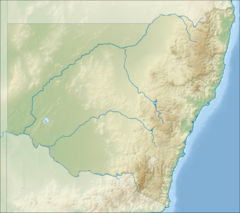Gundabooka National Park
| Gundabooka National Park | ||
|---|---|---|
| Flowers on Bennets Road in Gundbooka National Park | ||
|
|
||
| Location: | New South Wales , Australia | |
| Specialty: | Grassy woodland, petroglyphs, sheep stations | |
| Next city: | Bourke | |
| Surface: | 639.02 km² | |
| Founding: | April 1996 | |
The Gundabooka National Park is a national park in the northwest of the Australian state of New South Wales . It is 70 kilometers south of Bourke . The Mount Gunderbooka located in the park. Not far to the northeast is another national park , the Toorale National Park .
history
Originally this area was inhabited by Aboriginal tribes of the Ngemba and Paakandji , who are believed to have also created the petroglyphs and held ceremonies at specific locations in the park. The remains can still be seen today.
Especially during the dry season, the Aborigines sought out the area of the Gunderbooka Range, where there was most likely water in connection with the nearby Yanda Creek , a tributary of the Darling River , in the north of the park.
In the 19th century, the Darling River valley was explored by Charles Sturt , who also discovered the Gunderbooka Range in 1829. In 1857 a sheep breeding station was built on the Darling River below the mountains. Only a few shepherds came to the Gunderbooka Range. Only after the First World War was the land in the mountains distributed to soldiers returning after the war, who set up their own small sheep breeding stations there. Three of these stations, Ben Lomond , Belah and Mulgowan , are now integrated into the national park.
In 1996 the area of the Gunderbooka Range was declared a national park.
flora
The park is open, grassy woodlands mainly from eucalyptus ( Eucalyptus populnea spp. Bimble , Eucalyptus intertexta , Corymbia terminalis and Eucalyptus morrisii ), acacia ( Acacia excelsa ) and Callitris collumelaris there. Two rare bush species ( Pheballium glandulosum and Prostanthera stricta ) can also be found here.
fauna
The park is home to three endangered bat species ( Chalinolobus picatus , Saccolaimus flaviventris and Antechinomys lantier ). Different kangaroo species can also be found ( Macropus rufus , Macropus gigantius , Macropus fuliginosus , Macropus robustus erubescens ).
Three endangered bird species, the Inca cockatoo and two honeyeater species can also be seen in the park .
Web links
Individual evidence
- ↑ Note the different spellings for park and mountain.
- ↑ a b c d Gundabooka National Park - Culture and History . NSW Environment & Heritage Office
- ↑ Gundabooka National Park - Native vegetation . NSW Environment & Heritage Office
- ↑ a b Gundabooka National Park - Native Animals . NSW Environment & Heritage Office

